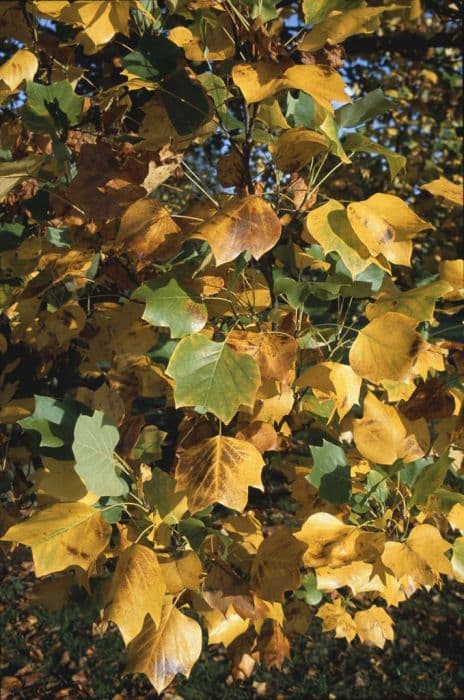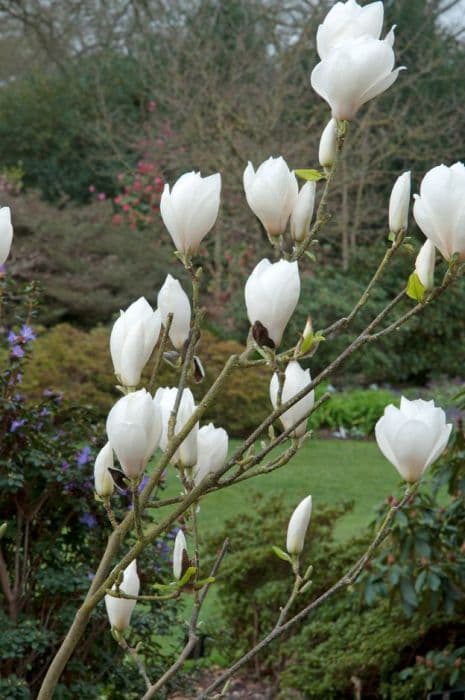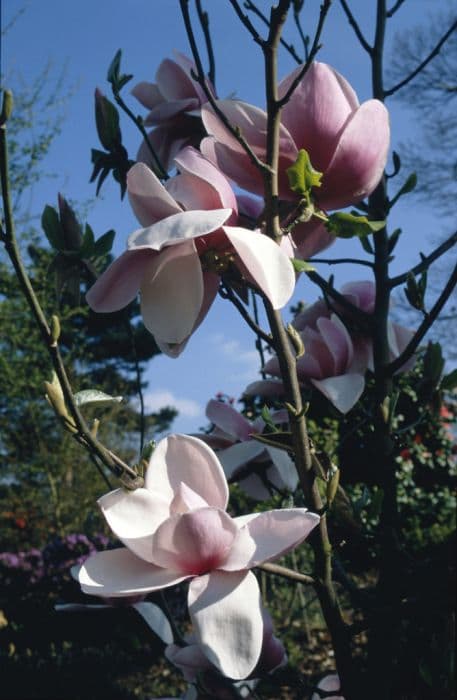Brooklynensis Magnolia Magnolia × brooklynensis 'Evamaria'

ABOUT
The Magnolia 'Evamaria' is a hybrid variety known for its distinctive floral display. Its flowers are large and showy, typically appearing before the foliage in early spring. These blooms exhibit a unique color palette, beginning as a deep purple-pink at the bud stage and gradually transitioning to a lighter pink or sometimes near white as they open fully. Each flower consists of several broad, thick, and waxy petals that form a cup-like shape and sometimes exhibit a slight fragrance. The leaves of 'Evamaria' are lush and glossy, developing after the flowers. They are typically obovate with a smooth margin and a leathery texture, providing a deep green backdrop that helps to highlight the plant's floral spectacle. In the autumn, the foliage may turn yellow or bronze before dropping, offering a display of fall color. The bark on this plant is smooth and gray, providing year-round interest even after the leaves have fallen. Since details regarding the size are excluded, it is adequate to say that the plant has a multi-stemmed habit with a generally rounded and spreading shape, which makes it an attractive specimen in a variety of garden settings. Its overall appearance is one that exudes elegance and can provide a captivating focal point when in bloom.
About this plant
 Names
NamesFamily
Magnoliaceae
Synonyms
Brooklyn Magnolia, Evamaria Magnolia
Common names
Magnolia × brooklynensis 'Evamaria'.
 Toxicity
ToxicityTo humans
The Brooklyn Magnolia is not widely known for being toxic to humans. Ingesting parts of the magnolia plant, including the Brooklyn Magnolia, might cause discomfort or an upset stomach in certain individuals due to the plant's naturally occurring compounds, but it is not considered highly toxic. There are no well-documented cases of serious poisoning from ingesting parts of magnolia trees.
To pets
The Brooklyn Magnolia is not generally considered to be toxic to pets either. While consumption of plant material may lead to gastrointestinal upset in some pets, such as vomiting or diarrhea due to the novelty of the ingested material, there are no significant toxic effects expected from the ingestion of Brooklyn Magnolia. If your pet has a tendency to chew on plants, it's always best to keep a watchful eye and consult with a veterinarian if any unusual signs are observed after ingestion.
 Characteristics
CharacteristicsLife cycle
Perennials
Foliage type
Deciduous
Color of leaves
Green
Flower color
Yellow
Height
30 feet (9 meters
Spread
20 feet (6 meters
Plant type
Tree
Hardiness zones
5
Native area
Cultivar
Benefits
 General Benefits
General Benefits- Aesthetic Appeal: Adds visual interest to gardens with its large, fragrant flowers typically blossoming in spring and early summer.
- Habitat for Wildlife: Attracts pollinators such as bees and butterflies, providing a resource for local ecosystems.
- Shade Provider: Can offer shade in garden landscapes due to its size when mature.
- Seasonal Interest: Provides seasonal color changes, with flowers in spring and changing leaf colors in autumn.
- Drought Tolerance: Once established, some Magnolia hybrids including 'Evamaria' have a degree of drought tolerance, requiring less water.
- Urban Tolerant: Can be suitable for urban environments, as it is relatively tolerant to pollution.
 Medical Properties
Medical PropertiesThis plant is not used for medical purposes.
 Air-purifying Qualities
Air-purifying QualitiesThis plant is not specifically known for air purifying qualities.
 Other Uses
Other Uses- Magnolia × brooklynensis 'Evamaria' sawdust or shavings can be used as a natural mulch to protect garden beds and maintain soil moisture.
- The wood of this magnolia can be crafted into small wooden objects like bowls or decorative pieces, showcasing its fine grain and potentially interesting colors.
- Leaves of 'Evamaria' magnolia can be steeped in hot water to create a natural dye for textiles in crafts or art projects, giving fabrics a light green or brown tint.
- Dried magnolia petals and leaves from this plant can be incorporated into potpourri mixtures, adding both fragrance and a touch of elegance to the mix.
- The sturdy branches of this magnolia can be used in floral arrangements, providing a strong structural base for more delicate flowers and foliage.
- Pressed magnolia leaves and flowers from 'Evamaria' can be used as decorative elements in crafting, such as creating bookmarks, greeting cards, or in scrapbooking.
- 'Evamaria' magnolia cones and seed pods can be collected and used in artistic endeavors or as part of decorative displays, especially in fall arrangements.
- The thick, leathery leaves can serve as a natural canvas for painting or drawing, allowing for eco-friendly art projects that integrate elements of nature.
- Magnolia x brooklynensis 'Evamaria' makes for an excellent photography subject, particularly when in full bloom, to capture the beauty of its large flowers.
- The plant can be trained and shaped as a bonsai, providing enthusiasts with a unique and challenging species to add to their collection.
Interesting Facts
 Feng Shui
Feng ShuiThe Brooklyn magnolia is not used in Feng Shui practice.
 Zodiac Sign Compitability
Zodiac Sign CompitabilityThe Brooklyn magnolia is not used in astrology practice.
 Plant Symbolism
Plant Symbolism- Perseverance: The Magnolia x brooklynensis 'Evamaria', commonly known as Brooklynensis Magnolia, often blooms boldly even in harsh environments, representing the ability to endure challenging conditions.
- Nobility: Magnolias are frequently associated with dignity and a regal presence, stemming from the plant's striking appearance and long history in ancient cultures.
- Feminine energy: The large, showy flowers of the Brooklynensis Magnolia are emblematic of femininity, grace, and beauty.
- Inner strength: With its sturdy trunk and branches, this magnolia variety symbolizes the internal fortitude and strength of character.
- Purity: The often white and beautifully shaped flowers can represent purity and innocence, an association common to many white flowering plants.
 Water
WaterBrooklyn Magnolia should be watered deeply to ensure the root zone is thoroughly moistened, typically requiring 1–2 gallons of water per week during the growing season, depending on the size of the tree and weather conditions. During the establishment period of the first few years, water once or twice a week, then reduce frequency as the tree matures. Allow the top inch of soil to dry out between waterings to encourage deep root growth. In dry periods without rainfall, you may need to increase watering frequency. During winter when the tree is dormant, water sparingly, just enough to prevent the soil from drying out completely.
 Light
LightBrooklyn Magnolia thrives in full sun to partial shade. It performs best when planted in a location that receives at least four hours of direct sunlight each day. Too much shade can lead to fewer flowers and a leggy growth habit. A spot that offers morning sun with some afternoon shade is ideal to protect the blooms from the harsh afternoon sun.
 Temperature
TemperatureBrooklyn Magnolia prefers moderate temperature conditions and is hardy in USDA zones 4 through 8, withstanding minimum temperatures down to -30°F. The ideal growing temperature for Brooklyn Magnolia is between 60°F and 70°F. They can tolerate summer heat up into the 90°F range, but extreme temperatures should be avoided.
 Pruning
PruningBrooklyn Magnolia benefits from pruning to maintain shape, remove any damaged or crossing branches, and to encourage healthy growth. Pruning should be done after flowering to avoid cutting off next year's buds. Prune sparingly as heavy pruning can reduce flowering; once a year or every other year is generally sufficient. The best time for pruning is late spring or early summer just after the blooming period.
 Cleaning
CleaningAs needed
 Soil
SoilThe Brooklyn Magnolia 'Evamaria' thrives best in rich, well-drained loamy soil with a slightly acidic to neutral pH, typically between 5.5 and 6.5. For optimal growth, a mix comprised of two parts loam, one part peat moss, and one part compost or well-rotted manure will create the ideal environment.
 Repotting
RepottingBrooklyn Magnolia 'Evamaria' does not need frequent repotting as it is a larger landscape plant; however, if planted in a container, it may require repotting every 3-5 years to refresh the soil and accommodate root growth.
 Humidity & Misting
Humidity & MistingBrooklyn Magnolia 'Evamaria' prefers moderate to high humidity levels but is adaptable and can tolerate the average outdoor humidity in most regions where it can be successfully grown.
 Suitable locations
Suitable locationsIndoor
Not suitable for indoor growth; requires open space.
Outdoor
Plant in well-drained soil with sun to partial shade.
Hardiness zone
4-8 USDA
 Life cycle
Life cycleThe common name of Magnolia × brooklynensis 'Evamaria' is Brooklynensis hybrid magnolia. The life cycle begins with seed germination, which is a result of cross-pollination typically by beetles attracted to the plant's large flowers. When conditions are right—sufficient warmth and moisture—the seed sprouts, and a seedling emerges, establishing a root system and a shoot that will grow into a sapling. As the sapling matures, it develops into a young tree, with the distinctive large, showy blossoms that may range from yellow to pink, blooming in late spring to early summer. Over the years, the tree experiences repeated growth cycles of budding, flowering, and seed production, usually beginning to bloom after it is several years old. With appropriate care and favorable conditions, a Brooklynensis hybrid magnolia can live for several decades, possibly even a century, eventually reaching maturity and then senescence, the final stage of its life cycle.
 Propogation
PropogationPropogation time
Spring-early summer
The most popular method of propagation for the Magnolia × brooklynensis 'Evamaria', commonly known as 'Evamaria' Magnolia, is through softwood cuttings taken in late spring or early summer. To propagate, cut a 4 to 6 inch (10 to 15 centimeter) portion of a healthy, non-flowering branch, making the cut just below a leaf node. Strip the leaves from the bottom half of the cutting and dip the cut end into a rooting hormone powder to encourage root development. Insert the cutting into a well-draining potting mix, ensuring that the leaf nodes where you removed leaves are buried in the soil. Cover the pot with a plastic bag or place it in a propagator to maintain high humidity and warmth, being careful not to let the plastic touch the leaves. Cuttings should be kept in indirect light and not allowed to dry out; roots typically form within a few weeks to months. Once rooted, the new Magnolia 'Evamaria' plant can be transplanted to a larger pot or directly into the garden.









